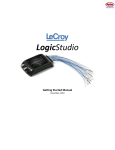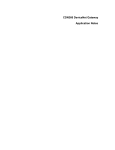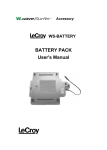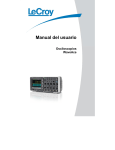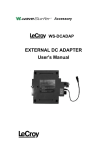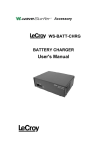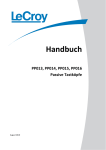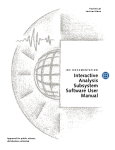Download Electronic SystemS TF-108 Operator`s manual
Transcript
Operator’s M anual TF-DSQ Probe Calibration and Deskew Fixture TF-DSQ Probe Calibration and Deskew Fixture Operator's Manual July, 2009 LeCroy Corporation 700 Chestnut Ridge Road Chestnut Ridge, NY, 10977-6499 Tel: (845) 578-6020, Fax: (845) 578 5985 Warranty LeCroy warrants this oscilloscope accessory for normal use and operation within specification for a period of one year from the date of shipment. Spare parts, replacement parts and repairs are warranted for 90 days. In exercising its warranty, LeCroy, at its option, will either repair or replace any assembly returned within its warranty period to the Customer Service Department or an authorized service center. However, this will be done only if the product is determined by LeCroy’s examination to be defective due to workmanship or materials, and the defect is not caused by misuse, neglect, accident, abnormal conditions of operation, or damage resulting from attempted repair or modifications by a non-authorized service facility. The customer will be responsible for the transportation and insurance charges for the return of products to the service facility. LeCroy will return all products under warranty with transportation charges prepaid. This warranty replaces all other warranties, expressed or implied, including but not limited to any implied warranty of merchantability, fitness or adequacy for any particular purposes or use. LeCroy shall not be liable for any special, incidental, or consequential damages, whether in contract or otherwise. Internet: www.lecroy.com © 2009 by LeCroy Corporation. All rights reserved. LeCroy, ActiveDSO, JitterTrack, WavePro, WaveMaster, WaveSurfer, WaveLink, WaveExpert, Waverunner, and WaveAce are registered trademarks of LeCroy Corporation. Other product or brand names are trademarks or requested trademarks of their respective holders. Information in this publication supersedes all earlier versions. Specifications are subject to change without notice. Manufactured under an ISO 9000 Registered Quality Management System. Visit www.lecroy.com to view the certificate. TF-DSQ-OM-E RevC 917299-00-RevA This electronic product is subject to disposal and recycling regulations that vary by country and region. Many countries prohibit the disposal of waste electronic equipment in standard waste receptacles. For more information about proper disposal and recycling of your LeCroy product, please visit www.lecroy.com/recycle. Operator's Manual TABLE OF CONTENTS TF-DSQ Overview .................................................................................... 6 Probe Calibration with the TF-DSQ Fixture.............................................. 6 Probe Calibration Steps with the TF-DSQ Fixture .................................... 7 TF-DSQ Connections ................................................................................ 8 TF-DSQ Fixture Overview ......................................................................... 8 TF-DSQ Fixture Elements ......................................................................... 9 Assembling the TF-DSQ fixture .............................................................. 10 TF-DSQ Oscilloscope Connection ........................................................... 11 Probe Connection to TF-DSQ ................................................................. 12 Probe Calibration .................................................................................. 14 Probe Calibration Menu......................................................................... 14 Accessing the Probe Calibration Menu.................................................. 14 Probe Calibration Menu Description ..................................................... 14 Basic Probe Calibration .......................................................................... 17 Advanced Mode Probe Calibration Menu ............................................. 17 Gain/Offset Only Calibration ................................................................. 17 Deskew Only .......................................................................................... 18 The Advanced Menu .............................................................................. 18 Rise Time Skew Correction .................................................................... 18 Deskew All (or Common Skew) .............................................................. 18 Common Mode Voltage Selection ......................................................... 19 Advanced Probe Calibration .................................................................. 19 Theory of Operation.............................................................................. 19 Deskew Theory of Operation ................................................................. 19 Deskew Risetime Adjustment Theory.................................................... 22 DC Calibration Theory ............................................................................ 24 Probing Basics ....................................................................................... 25 Single-Ended and Differential Probe Basics ........................................... 25 Operating Environment ......................................................................... 28 iv TF-DSQ-OM-E RevC TF-DSQ Probe Calibration and Deskew Fixture Safety Precautions ................................................................................ 28 CERTIFICATIONS .................................................................................... 28 CE Declaration of Conformity ................................................................ 28 EMC Directive ........................................................................................ 28 Electromagnetic Emissions: ................................................................... 29 Electromagnetic Immunity: ................................................................... 29 Low-Voltage Directive............................................................................ 29 Index .................................................................................................... 30 TF-DSQ-OM-E RevC v Operator's Manual TF-DSQ Overview Probe Calibration with the TF-DSQ Fixture The TF-DSQ fixture is used in conjunction with the oscilloscope software to perform probe deskew and DC calibration. It has the following leading features and specifications: Deskew to +/- 20 ps typical accuracy Differential and single-ended drive 75 ps edge Calibration of DC gain and offset and skew at same probing point Accounts for risetime variations Accounts for common-mode voltage DC gain calibration accounts for probe loading effects Integrated operation with oscilloscope for fully automatic calibration WavePro 7 Zi and WaveMaster 8000 WaveMaster 8 Zi WavePro 7000 Oscilloscopes and SDA/DDA Oscilloscopes and SDA/DDA Oscilloscopes Models, also DDA 5005A, 7 and 8 Zi Models 5005A XXL Oscilloscope Connection ProLink and ProBus ProBus Only ProLink Only Probes Supported D610,D620, D600A-AT, D310, D320, and D300A-AT with all probing accessories AP020, AP033, AP034 HFP1000, 1500, 2500, and 3500, PP005 and PP005A DC Range ±5 V single-ended, ±10 V differential DC Accuracy ±(1% + 600 μV) Edge Risetime (of Device) 75 ps (typical) < 95 ps (guaranteed) Edge Amplitude and Rep Rate Approximately 800 mV @ 10 MHz Deskew Accuracy ±20 ps (typical) 6 TF-DSQ-OM-E RevC TF-DSQ Probe Calibration and Deskew Fixture Probe Calibration Steps with the TF-DSQ Fixture Probe calibration is accomplished with the TF-DSQ fixture by following the steps in the following flowchart. Note: It is recommended that you read the instructions presented here in their entirety to familiarize yourself with the advanced features of the TF-DSQ fixture prior to use. The combination of TF-DSQ fixture and oscilloscope software is designed with an important use model. Connecting probes to the circuit under test can be a difficult procedure. LeCroy's system, therefore, is designed in a manner that allows you to set up the probe calibration fixture, calibrate each individual probe once, connect your probes to the circuit, and disconnects the fixture. Once your probes are in the circuit, there is no need to revisit the fixture until the next calibration interval. Familiarize yourself with the following topics: TF-DSQ fixture overview TF-DSQ Oscilloscope Connection Probe Calibration Menu access Probe connection to fixture Calibrating probes TF-DSQ-OM-E RevC 7 Operator's Manual TF-DSQ Connections TF-DSQ Fixture Overview The TF-DSQ fixture comes in a soft case containing a CD with .pdf versions of the manuals for several oscilloscope options, along with the following components: The TF-DSQ fixture A 50-ohm SMA cable ProBus extender complete with BNC to SMA adapter (TF-DSQ-PBE) 8 TF-DSQ-OM-E RevC TF-DSQ Probe Calibration and Deskew Fixture A ProLink extender A BNC to SMA adapter (not pictured) TF-DSQ Fixture Elements TF-DSQ-OM-E RevC 9 Operator's Manual Assembling the TF-DSQ fixture See the fixture overview to identify individual components. System assembly is accomplished in the following steps: 1. Connect one end of the 50 Ω cable to the desired ProLink or ProBus extender (with adapter). 2. Connect the other end of the 50 Ω cable to the SMA connector on the TF-DSQ fixture. 3. Connect the ProLink or ProBus CAT 5 cable from the extender to the TF-DSQ fixture. Note: The 50 Ω connection should be torque tightened with an RF torque wrench and must be properly tightened. 10 TF-DSQ-OM-E RevC TF-DSQ Probe Calibration and Deskew Fixture TF-DSQ Oscilloscope Connection The TF-DSQ fixture is connected to either an unused oscilloscope channel or the external AUX IN input, if one exists. In other words, any oscilloscope channel or oscilloscope input with a ProLink or ProBus connector. Scope Auxiliary Input with ProLink and BMA Connector Connection of the TF-DSQ Fixture to the Oscilloscope Input We recommend connecting to the AUX IN input, or to an unused oscilloscope channel in the case of a Serial Data Analyzer with the "A" model suffix (these oscilloscopes replace the external trigger input with a clock recovery module). Note: Your kit contains both ProBus and ProLink extenders, so regardless of the AUX IN input used for your signal (BNC or BMA), your specific connection need is covered. The TF-DSQ fixture is called out as the probe calibration source on the probe calibration menu. Seeing this option on the menu verifies proper operation. TF-DSQ-OM-E RevC 11 Operator's Manual Probe Connection to TF-DSQ The TF-DSQ provides multiple probe connectors for various kinds of probes. Probes are connected electrically in either a single-ended or differential arrangement, depending on the type of probe. Probes are connected mechanically using either the probing pads, or a probing clip provided for solder-in probing solutions. Figure 4-1. Probe Connection Points and the Clip Differential probes are connected with the tip designated V+ mated to the "+" pad on the fixture, and the tip designated V- to the "-" pad on the fixture. Single-ended probes are connected with the probe tip connected to the V+ pad only, and the ground lead optionally connected to ground. Solder-in probes have their appropriate tips held down to the microstrip transmission line by the clip. Simply push down on the clip with your thumb, insert the probe connection leads under the clip and release. Make sure that V+ and V- are connected properly. Figure 4-2. Single-ended Probe Properly Connected to the Fixture 12 TF-DSQ-OM-E RevC TF-DSQ Probe Calibration and Deskew Fixture Figure 4-3. Differential Probe Properly Connected to the Fixture (Browsing Configuration) Figure 4-4. Differential Probe Properly Connected to the Fixture (Solder-in Configuration) TF-DSQ-OM-E RevC 13 Operator's Manual Probe Calibration Probe Calibration Menu Accessing the Probe Calibration Menu The probe calibration menu can be accessed from the Vertical drop-down menu or from the Channel (sometimes referred to as Vertical Adjust) dialog: Probe Calibration Menu Description Figure 4-5. The Probe Calibration dialog contains information and controls. The information on the probe calibration dialog is organized so each row represents the information for a given channel and each column represents the calibration information or control for that channel. For each channel, the information and controls provided include: 14 The channel number in the colored button icon and the probe type that is installed A Full Calibration button, which starts the calibration DC correction information including both gain and offset correction The skew correction A Clear button TF-DSQ-OM-E RevC TF-DSQ Probe Calibration and Deskew Fixture Note: The Cal Skew Ref field (and others) shows EXT for External Trigger Input. This may also be more aptly referred to as AUX for Auxiliary Input. This Probe Calibration dialog field could also be a channel. PROBE CHANNEL AND TYPE IDENTIFICATION This area shows the type of probe connected to the channel. All other information shown in a given row is associated with that probe. FULL CALIBRATION BUTTON This button causes the oscilloscope to automatically perform a full DC and deskew calibration. See details of probe DC calibration or probe deskew calibration. PROBE DC INFORMATION This information shows the gain and offset applied to the probe. If the probe measures a voltage of V, the new, calibrated voltage is: Note that the offset is in Volts, and the gain is unitless. The probe DC calibration information can be entered either manually or as the result of an automatic calibration. In the case of automatic calibration, it can be part of the full calibration or it can be a standalone DC calibration executed in advanced mode. When the DC calibration information is a result of an automatic calibration utilizing the TF-DSQ fixture, the information shown is the gain and offset utilized for the currently configured channel sensitivity (volt/division setting; see details of DC calibration). In this case, when the channel sensitivity is altered, notice that these values change. When the DC calibration information is entered manually, it clears any automatic results and replaces them globally with the newly entered values. This means that if new gain and offset numbers are entered manually, these values apply across all oscilloscope sensitivity settings. The gain is limited to between 0.8 and 1.2, but the offset is not limited. Note: It is important to note that some passive probes, and any user-designed probes, do not provide proper probe identification information to the oscilloscope. In these cases, the oscilloscope may not be able to determine the proper attenuation values. In this situation, you should make sure that the proper attenuation is entered in the channel "Vertical" setup dialog. Furthermore, the gain entered should be the gain correction applied to the system with the correctly entered attenuation. TF-DSQ-OM-E RevC 15 Operator's Manual PROBE DESKEW INFORMATION The probe deskew information contains the measured skew between the probe in the specified channel and the reference channel. It can be entered manually or as the result of an automatic calibration. In the case of automatic calibration, it can be the result of a portion of the full calibration-1427781181 or it can be the result of a standalone deskew calibration. Even after the deskew has been performed automatically, the deskew correction can be tweaked manually. CLEAR All probe calibrations can be cleared by pressing this button corresponding to a probe. PROBE CALIBRATION SOURCE This specifies the signal source used for DC and skew calibrations. When the TF-DSQ fixture is plugged into an oscilloscope input, the oscilloscope automatically specifies this fixture as the calibration source. SKEW REFERENCE This specifies the channel or external input where the skew reference is supplied. The skew reference is the absolute time reference to which all deskew measurements are made. When the TF-DSQ fixture is plugged into an oscilloscope input, the oscilloscope detects this and automatically shows the front panel connection of the fixture. RECALL CALIBRATION Whenever a probe calibration is applied, the oscilloscope saves the information in a file on the disk. If the oscilloscope must be rebooted for any reason, the probe calibration information is always cleared, but can be manually recalled by pressing this button. ADVANCED MODE CHECKBOX When the Advanced Mode checkbox is unchecked, you have access to the basic probe calibration menu. The basic probe calibration menu shows you only what is absolutely needed to perform a simple calibration of the probes. In other words, it shows you the calibration information and provides the capability to calibrate the probe with a single button press, clear the calibration information, and manually reload the calibration information following an oscilloscope reboot. When the advanced mode button is checked, you have access to the advanced mode probe calibration menu. 16 TF-DSQ-OM-E RevC TF-DSQ Probe Calibration and Deskew Fixture Basic Probe Calibration The TF-DSQ fixture is used to calibrate probes. Prior to beginning your measurements: 1. Assemble the TF-DSQ fixture 2. Attach the fixture, ideally to the Auxiliary Input or an unused oscilloscope channel 3. Access the Probe Calibration Menu Now, follow these steps for each probe used: 1. 2. 3. 4. Connect the probe to the oscilloscope channel Attach the probe to the TF-DSQ fixture Press the Full Calibration button in the Probe Calibration Menu. Wait a few seconds as the probe is calibrated (calibration wizard closes at end of calibration). 5. When the calibration completes, remove the probe from the TF-DSQ fixture Now you are ready to probe the circuit and perform your measurements. If power is interrupted during your measurements, reboot the oscilloscope and manually recall your settings. Advanced Mode Probe Calibration Menu The advanced mode is entered by checking the advanced mode box at bottom-right of the basic probe calibration dialog: Checking this box allows: Calibration of gain/offset only Calibration of deskew only Access to the advanced menu (shown as a tab behind the Probes Cal dialog) Gain/Offset Only Calibration Pressing this button performs only the DC calibration of the probe on the specified channel. See details of Probe DC Calibration. TF-DSQ-OM-E RevC 17 Operator's Manual Deskew Only Pressing this button performs only the deskew calibration of the probe on the specified channel. See details Probe Deskew Calibration. The Advanced Menu The Advanced Menu contains information and functionality useful to the advanced user of the TF-DSQ fixture. These include: Risetime Skew Correction Deskew All (or common deskew capability) Common mode voltage settings for DC calibration Rise Time Skew Correction This field shows the signal risetime and the corresponding skew correction based on the signal risetime. When probes are deskewed, the risetime measurement of the edge used for deskewing is displayed in the Rise Time field corresponding to the probe and probe channel, and an additional skew correction of zero is applied. The measured risetime of the signals encountered can be entered into the Rise Time field, and the oscilloscope automatically calculates and applies a new skew correction value to be utilized in addition to the deskew amount calculated during the deskew calibration procedure. With this use, a finer deskew calibration is performed because the risetimes of the signals measured are accounted for. See details of risetime correction. Deskew All (or Common Skew) This is the deskew amount applied to all channels. The time entered in this field is the absolute time by which all waveforms displayed by the oscilloscope are delayed in time. This value effectively adjusts the zero time reference of the system. See Probe Deskew Calibration for details. 18 TF-DSQ-OM-E RevC TF-DSQ Probe Calibration and Deskew Fixture Common Mode Voltage Selection The TF-DSQ fixture calibrates probes differentially or in single-ended mode depending on the type of probe. Differential probes allow the common mode voltage component to be applied during the DC calibration for improved calibration accuracy in situations where probe gain or offset correction depends on common mode components. See Probe DC Calibration or Differential and Single-ended Probe Basics for details. Advanced Probe Calibration When the Advanced Mode checkbox is checked, you can perform the DC calibration and the deskew calibration separately by pressing Gain/Offset Only or Deskew Only. When performing DC calibration, you have the option to apply a common mode component to the differential DC levels applied to the probe during calibration. See Probe DC Calibration or Differential and Single-ended Probe Basics for details.. After performing the deskew calibration, you have the option to apply a common skew value to all channels to adjust the zero time reference of the system. If you know the risetime of the signals being measured, you can enter the measured risetime of the signals in the Rise Time field to obtain a further skew correction that accounts for the risetime. If the risetime entered is less than the risetime measured during the calibration, no correction is applied; otherwise, the system calculates a correction to account for the signal risetime. It is important to enter the measured risetime. That is the risetime of the signal that the oscilloscope measures (or will measure). See details of risetime correction. Theory of Operation Deskew Theory of Operation Deskewing is an adjustment of the times of waveform data points on the screen. Deskewing is an operation to correct the times that waveforms are displayed on the screen, mainly to account for propagation delays through probes and cables. When considering skew, there are two important things to consider: The relative skew between two channels The absolute skew from the zero time reference (i.e., the trigger point) TF-DSQ-OM-E RevC 19 Operator's Manual Two channels are properly deskewed relative to each other when the difference between the deskew values entered for each channel aligns an edge occurring at the same time and applied to both channels. A channel is properly deskewed in an absolute sense when an edge is applied to that channel, the oscilloscope is triggered on that edge, and that edge appears such that the trigger threshold crossing appears at the trigger delay, which is the zero time reference on the oscilloscope screen. Probes are deskewed one at a time relative to a reference such that the resulting calibration deskews each probe relative to every other probe. The TF-DSQ fixture has a built-in step generator. The edge generated is driven out of a cable into an oscilloscope channel or external input where the fixture is connected. The edge is simultaneously driven onto a transmission line containing the probing pads. When a probe is connected to the probing pads, the edge appears at the fixture connection to the oscilloscope and on the channel where the probe is connected. Generally, there is a difference in time between the edges due to propagation delay variations between the fixture cabling and the probe. During the deskew procedure, the oscilloscope triggers on the channel or external input used for the fixture connection and the time from this trigger to the edge on the probe channel being deskewed is calculated. This time becomes the skew time for the probe. This process is repeated for all of the other probes being utilized. During oscilloscope operation, there is a small dilemma. Each probe that is deskewed causes the waveform to be delayed or advanced due to the deskew time calculated for the channel. This causes the trigger to be misaligned because the trigger point is where the edge reaches the internal oscilloscope trigger circuitry, not when the edge appears at the probe tips. The oscilloscope accounts for this by subtracting the deskew correction for the channel used as the trigger source from the deskew correction on all channels. In essence, the channel used as the trigger source has zero deskew correction applied, while the relative deskew difference between all channels is maintained. This trigger compensation is hidden from the user. If better trigger alignment is desired or if there is some need to shift all of the waveforms, provide a Deskew All field value on the Advanced dialog to shift all traces together. 20 TF-DSQ-OM-E RevC TF-DSQ Probe Calibration and Deskew Fixture The following example illustrates this scenario: Two probes are used in a system. They are connected to channels 2 and 3. The TF-DSQ fixture is connected to channel 4. When the oscilloscope is triggered on channel 4, you observe the following edges: When the probes are deskewed, the relative time between channel 4 (where the TF-DSQ fixture is connected) and channel 2 is calculated as 30 ps, and -30 ps and is entered in channel two's skew entry. Similarly, the time between channel 4 and channel 3 is calculated as 40 ps and -40 ps is entered in channel 4's skew entry. When triggering on channel 4, channel 2 is advanced 30 ps in time and channel 3 is advanced 40 ps in time such that all of the edges are aligned with each other and with the trigger point. When triggering on channel 2, these times are adjusted by a common 30 ps. So, 30 ps is added to channel 2 to cause 0 deskew amount, and 30 ps is added to channel 4 to cause -10 ps deskew. Without this common addition (or delay) of all waveforms by 30 ps, all edges would remain aligned, but channel 2's trigger position would be off by 30 ps. This explains how the 30 ps (commonly added to all waveforms) keeps the trigger points aligned. TF-DSQ-OM-E RevC 21 Operator's Manual Deskew Risetime Adjustment Theory Two scenarios require adjustment of the deskew values to account for risetime: 1. Two probes are used for relative time measurements, but each probe has a different risetime. 2. Two probes are used for relative time measurements, but each signal has a different risetime. The first case is explained here with obvious analogy to the second case. Two probes are often utilized for measurements where each probe has a different risetime. This may occur because you are making a measurement where a reasonably low bandwidth probe can be used, but you do not have two of same probe, so you end up using a second one with a higher speed than the first. When the probes are deskewed, the high-speed edge from the TF-DSQ fixture is utilized. The deskewed probes might show signals that look like the following when the high-speed edge supplied by the TF-DSQ fixture is observed: In the previous picture, the green trace edge is the one actually supplied by the TF-DSQ fixture. However, because of risetime limitations of the probe and channel, the edges appear as the red and blue traces. These traces are shown aligned at the 50% crossing point at the end of the deskew calibration. 22 TF-DSQ-OM-E RevC TF-DSQ Probe Calibration and Deskew Fixture Now, let's assume that these probes are applied to signals with the same risetime, but a different risetime than the one applied by the deskew fixture: This example clearly illustrates how the application of signals with the same risetime (but different risetime than the one applied by the deskew fixture) produces a deskew error, unless compensated. In the previous figure, the green trace is the actual signal applied to the probes that has a risetime of twice that employed by the fixture. The red and blue traces represent the trace acquired through the probes and channel due to this edge. Because of the different risetime applied, there is a small error. A possible solution to this would be to vary the risetime of the edge applied to the probe by the fixture; a very difficult design. Despite this difficulty, a variable risetime solution would require knowing what the measured risetimes would be ahead of time or to measure the risetimes first. TF-DSQ-OM-E RevC 23 Operator's Manual The TF-DSQ fixture, in accordance with the philosophy of requiring only one calibration in the fixture, handles this in a special manner. The user simply enters the measured risetime of the signals after the probe is connected to the circuit. Since the oscilloscope software saves the edge acquired during the deskew calibration process, it applies this saved edge to a variable filter using digital signal processing until the measured risetime is achieved. At that point, the software calculates the difference in the time of the 50% crossing and calculates an additional skew correction to be applied. In this manner, the risetime is compensated for in the deskew calibration without the requirement of re-calibrating. The previous figure shows the traces realigned as a result of the skew correction applied after the measured risetime has been entered. DC Calibration Theory DC calibration involves the calculation of two constants to be applied to waveforms to correct for voltage measurement inaccuracy. The two constants are the gain (applied multiplicatively) and the offset ( applied additively). It is important to distinguish the gain and offset correction from the channel gain determined by the sensitivity control (volts/division selection) or the offset control. The sensitivity and offset controls change the absolute gain and offset of the front end amplifier, but cannot correct for inaccuracy. This is also true with the vertical gain and offset controls in zooms. The way to visualize this is to place a cursor at a point on a waveform and read the voltage. Adjusting volts/div or offset, or adjusting the gain or offset of a zoom, affects the size of the waveform on the screen, but does not affect the voltage measured at the cursor position. 24 TF-DSQ-OM-E RevC TF-DSQ Probe Calibration and Deskew Fixture The gain and offset correction applied during DC calibration affects the voltage measured according to the following formula: where V is the voltage measured prior to calibration. Probes are calibrated for each fixed gain setting of the oscilloscope, meaning they are calibrated at 10, 20, 50, 100, 200, 500 mV and 1V per division. A unique gain and offset calculation is made for each range. The calibration of the probe is performed utilizing 5 DC levels. The DC levels are applied such that the voltages ideally appear on the oscilloscope screen at -3, -1.5, 0, 1.5 and 3 vertical divisions. The best fit line is calculated, and the appropriate gain and offset that would make the line fit the actual voltages applied is also calculated. The gain and offset for each range is the gain and offset correction displayed in the gain and offset fields. In all cases, the DC levels applied to the probe are measured by an ADC on the fixture placed near the probing points. In this way, the absolute voltage at the probe tips is precisely known and any DC probe loading effects are taken into account. In the case of single-ended probes, the DC levels applied to the V+ probing pad are the same as the voltages that appear at the appropriate grid locations on the oscilloscope screen. Differential probes are handled slightly different. In their case, the voltage applied to the V+ tip is the voltage specified in the Common mode voltage field, plus half the voltage desired on the oscilloscope screen. The voltage applied to the V- tip is the common mode voltage minus half the voltage desired. In this way, the probe experiences the specified common mode voltage, and the differential voltage measured by the probe is calibrated for common mode voltage effects. Probing Basics Single-Ended and Differential Probe Basics Single-Ended and Differential probe discussions are a sometimes confusing subject. There are aspects of operation that must be known in order to understand their calibration. Single-Ended A single-ended probe exposes a probing tip and a ground connection lead. Typically, the ground lead is connected to the outer conductor in a coaxial cable, which is connected directly to the oscilloscope's ground. The probing point is typically connected to the center conductor. Typically, the ground connection represents an essentially zero-ohm connection to oscilloscope ground, and the probe tip is a specified impedance to that ground. Other than probes, a 50-ohm cable is often used for single-ended measurements. TF-DSQ-OM-E RevC 25 Operator's Manual In this case, the outer conductor connects the oscilloscope's ground to the circuit's ground, and the cable is terminated with 50 ohms at the oscilloscope, such that the conductor looks like 50 ohms looking into it at all frequencies. In the case of single-ended measurements, the oscilloscope is measuring the difference between the probe tip and ground. Since ground is considered to be zero volts, one can say that the voltage measured at the probe tip is the absolute voltage. Differential A differential probe, in contrast, exposes two probing tips with an optional ground connection lead. Often, the ground connection lead is left unconnected (more on this later). Each of the probe tips are connected to two different signals in a circuit. The probe measures only the difference between the two probing points with no actual notion of the absolute voltages present. In practice, differential probes have limitations not only on the difference allowed between the two probing tips, but also the absolute voltage allowed. This absolute voltage is referenced to the oscilloscope's ground. For this reason, the probe ground lead is sometimes connected to ground in the circuit to make oscilloscope ground and circuit ground the same. This is often done only when the circuit is floating, which means that the circuit's ground is free to move to any voltage, depending on its ground connections. Despite the differential probe only measuring the difference between the voltages at its probe tips, its accuracy is sometimes affected by the absolute voltages present. Differential signaling is used commonly for high-speed signals. In a differential system, two wires are used to transmit the signal. Often, the signals are the direct opposite of each other, with both swinging across zero volts. Frequently, these signals have a common offset or bias applied to them. In this case, the common offset applied to each signal is called the common mode signal component, and the difference between each signal is called the differential mode signal component. Typically, the differential signal is the actual information signal being transmitted, with the common mode signal being present for other physical reasons, such as the biasing of an ECL gate. An ideal differential probe receives only the differential mode signal. Practical probes reject the common mode signal to a large extent. The ability of a differential probe to reject the common mode signal is stipulated by the common mode rejection ratio (CMRR). 26 TF-DSQ-OM-E RevC TF-DSQ Probe Calibration and Deskew Fixture Despite differential probes measuring differentially, they can be used to measure common mode signals. In this case, the V- tip is connected to ground, and the probe continues to measure the difference between the tips. This is a useful configuration for identifying ground problems. The voltages in differential systems can be described by the following diagram and equations: TF-DSQ-OM-E RevC 27 Operator's Manual Operating Environment Before using your accessory, ensure that its operating environment will be maintained within these parameters: Temperature: 5 to 40 °C. Humidity: ≤ 80% RH (non-condensing). Altitude: 2000 meters Max. Safety Precautions CAUTION Avoid personal injury or damage to your accessory or any equipment connected to it by reviewing and complying with the following safety precautions: Use only as intended. The accessory is intended to be used only with the compatible LeCroy instruments. Use of the accessory and/or the equipment it is connected to in a manner other than specified may impair the protection mechanisms. Connect and disconnect properly. Avoid damage through excessive bending. Do not use in wet/damp or explosive atmospheres. For indoor use only. The accessory is intended for indoor use and should be operated in a clean, dry, environment. Do not operate with suspected failures. Do not use the product if any part is damaged. All maintenance should be referred to qualified service personnel. Keep product surfaces clean and dry. CERTIFICATIONS CE Compliant CE Declaration of Conformity The accessory meets requirements of EMC Directive 2004/108/EC for Electromagnetic Compatibility and Low Voltage Directive 2006/95/EC for Product Safety. EMC Directive EN 61326-1:2006 EMC requirements for electrical equipment for measurement, control, and laboratory use. 28 TF-DSQ-OM-E RevC TF-DSQ Probe Calibration and Deskew Fixture Electromagnetic Emissions: EN 55011/A2:2002, Radiated and conducted emissions (Class A)* Electromagnetic Immunity: EN 61000-4-2:2001 Electrostatic Discharge. (4 kV contact, 8 kV air, 4 kV vertical/horizontal coupling planes) EN 61000-4-3:2006 RF Radiated Electromagnetic Field. (3 V/m, 80-1000 MHz; 3 V/m, 1400 MHz - 2 GHz; 1 V/m, 2 GHz - 2.7 GHz) * This is a Class A product. In a domestic environment this product may cause radio interference, in which case the user may be required to take appropriate measures. Low-Voltage Directive EN 61010-031:2002 Safety requirements for electrical equipment for measurement, control, and laboratory use. TF-DSQ-OM-E RevC 29 Operator's Manual Index deskew risetime adjustment, 21 C differential & single-ended probes, 24 gain & offset, 23 calibration: probe, 13 high-speed edge, 21 P probe calibration, 13 overview, 7 probe calibration menu, 13 probe connection, 11 probe DC information, 14 T TF-DSQ, 5 probe deskew information, 15 recall calibration, 15 absolute skew, 19 relative skew, 19 advanced probe calibration, 18 rise time skew correction, 17 assembly, 9 scope connection, 10 basic probe calibration, 16 skew reference, 15 common mode, 18 specifications, 5 DC calibration theory, 23 step generator, 19 DC levels, 24 trigger alignment, 19 deskew all, 17 30 TF-DSQ Overview, 5 TF-DSQ-OM-E RevA Thank you for purchasing a TF-DSQ Probe Calibration and Deskew Fixture.































